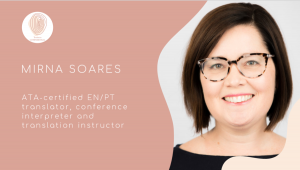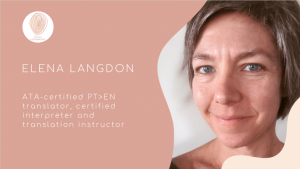Rafa Lombardino, PLD Blog Editor
We have all had to adapt during the global pandemic. And students are among those who have had to drastically change their routines in order to continue making progress in their studies. From elementary through high school kids and college students, as well as those working towards a T&I degree or professional certificate, all are impacted.
We interviewed some translation and interpretation instructors to learn how they have continued to support their students during this COVID-19 pandemic. (Read Part 1 here)
 I’ve been teaching at the University of Maryland for two and a half years. I teach the Portuguese-specific portion of translation courses in Graduate Studies in Interpreting and Translation, including “Fundamentals of Translation,” “Sight Translation,” and “Independent Study,” which is an intensive writing course in Portuguese. Coincidentally, I had been teaching online for a couple of months before the pandemic began. The Portuguese cohort is small and it’s not that hard to move things to an online environment. Besides, some of my students had already graduated or moved on to other online courses.
I’ve been teaching at the University of Maryland for two and a half years. I teach the Portuguese-specific portion of translation courses in Graduate Studies in Interpreting and Translation, including “Fundamentals of Translation,” “Sight Translation,” and “Independent Study,” which is an intensive writing course in Portuguese. Coincidentally, I had been teaching online for a couple of months before the pandemic began. The Portuguese cohort is small and it’s not that hard to move things to an online environment. Besides, some of my students had already graduated or moved on to other online courses.
When we started socially isolating due to COVID-19, UMD offered us many resources. We received a lot of information, we had webinars about how to move courses online, and they offered us Zoom for live classes. We already used Canvas to communicate with students and exchange documents. UMD also offered the “Keep Teaching” website, which taught me three key principles: (1) Keep it simple, or don’t try to reinvent the wheel, (2) Don’t try to be perfect, and (3) Be honest, transparent, and respectful. We know we’re all in this together, and people may really be struggling, perhaps because they’re sick, someone in their family is sick, or they’re just stressed by the whole situation. We have to be more flexible about grades, class schedules, deadlines and all that.
I also have personal experience with online classes because I am in a master’s program with the University of Geneva, so I’m taking all their classes online. They’ve also been very good at giving us options and telling us that we can talk to them if we have any issues. I think they were very sensitive to how people are stressed, and there’s a discussion thread dedicated to COVID-19, so that we can keep the conversation centralized and separate from academic matters. That’s giving us an opportunity to vent or post beautiful pictures of our gardens or things to lift each other’s spirits. There’s a lot we can do in an online environment, even though I do miss seeing people’s reactions right in front of me.
 I’ve been teaching interpreting and translation since 2005, when I was a graduate student. I’m currently teaching at a variety of institutions, in several different courses and with various approaches to teaching platforms. For example, I teach “Healthcare Interpreting” at the Master’s of Conference Interpreting program at Glendon College, which is part of York University in Toronto, Canada. It’s an online, language-neutral class, and we use Moddle as a teaching platform and Adobe Connect for our live meetings.
I’ve been teaching interpreting and translation since 2005, when I was a graduate student. I’m currently teaching at a variety of institutions, in several different courses and with various approaches to teaching platforms. For example, I teach “Healthcare Interpreting” at the Master’s of Conference Interpreting program at Glendon College, which is part of York University in Toronto, Canada. It’s an online, language-neutral class, and we use Moddle as a teaching platform and Adobe Connect for our live meetings.
I’m also teaching at the University of Massachusetts Medical School, which is a 60-hour medical interpreting training program. It used to be in-person, but a couple of years ago I started to transition it into a hybrid program, so we would meet for part of it online. I was using Zoom before it actually got so big and famous, but I also experiment with free, online learning platforms. One of them is Google Classroom, because it’s simple, and I saw it in use with my own children. After we have a Zoom session, I use it to upload quizzes and recorded meetings, as well as additional materials, such as videos and glossaries.
Before COVID-19, one of my programs that went through the most change was the one with classes in Brighton, Massachusetts, which is about 90 miles from where I live. It’s an evening class and I would drive for about ninety minutes, teach for three hours, then drive back home. During a transitional period, I started teaching some of those sessions from home through live online meetings, allowing the students to also attend from home.
After COVID-19, I was forced to take all my classes online. That group was actually able to meet in person once, on March 10, and I remember telling them in class, “I don’t think we will need to go online, but if we do, you guys are in luck, ’cause I know how to make that happen and I have a back-up plan.” The following day, the University of Massachusetts Medical School told us that we’d all have to take our classes online. At least we had that one class in person, so people got to meet each other.
Another approach I have to online teaching―and this one is for the undergraduate program that can be part of a bachelor’s degree through the University Without Walls at Amherst―is language-neutral classes that are run on Blackboard. None of the classes are live. So the program is asynchronous and students are never required to be online at a precise time. Over my years of teaching, this has been an approach that I really like, but I think we all felt the need to meet live more often. Because students receive a syllabus once they sign up, and that syllabus is kind of a contract between instructors and students, you can’t require anyone to do anything that is not in the syllabus. So, I started offering live meetings, but they were optional.
Frankly, the way I did things this semester was really low-key. The live sessions weren’t really classes―they were just check-ins, so we could talk about whatever the students wanted to. It did mostly end up being related to the class, but they were more like open office hours. The challenge with this format, which is the reason we didn’t do it before, is that the University of Massachusetts program attracts students from all over the world. This semester, I had a student in Japan who was in the Spanish track, and then I had a Japanese student who was in the Japanese track, but living in Mexico. There’s not much of a time difference between Massachusetts and Mexico, but it would be a challenge for the student in Japan to attend live sessions.
The biggest challenge with COVID-19, for me as an instructor and for my students, was to maintain focus on doing the work when everything else was so different. It seemed, at first, that it would be easy for us to transition, because we were already online. You know, what’s the difference? But context is everything, just like it is with translation and interpreting. Given that our context had changed so dramatically, we weren’t able to just carry on as if everything were normal. Therefore, even something that was pre-programmed to be online and asynchronous had its difficulties. It certainly wasn’t my best semester as an instructor, and the students struggled a lot, too. There were more requests for flexibility and extension of deadlines than ever before.

Leave a Reply